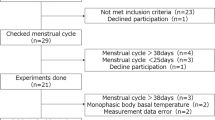Abstract.
We studied 16 women 21–23 years old with regular menstrual cycles (28±4 days) and no history of knee injury. From their basal body temperatures and the serum concentrations of estradiol and progesterone, the follicular, ovulatory, and luteal phases were delineated. Using a KT-2000 arthrometer, anterior displacement at 89 N and 134 N and anterior terminal stiffness (N/mm) at 134 N were measured two or three times every week over a 4-week period. Eight men 21-23 years old were also measured. In women the anterior displacement at 89 N varied between the follicular and the ovulatory phase and between the follicular and the luteal phase (P<0.05) and at 134 N between the follicular and the luteal phase (P<0.05). There were no statistical differences in the anterior displacement with time in men, nor in anterior terminal stiffness in either sex. We conclude that anterior cruciate ligament laxity in women might be dependent on the concentrations of hormones.
Résumé.
Nous avons étudié seize femmes agées de 21 à 23 ans avec des cycles menstruels réguliers (28±4 jours) et sans antécédents de traumatisme du genou. Les phases folliculaire, ovulatoire et lutéale ont été délimitées à partir des températures corporéales basales et des concentrations sériques d'œstradiol et de progestérone. En utilisant un arthrométre KT-2000 le déplacement antérieur sous 89 N et 134 N et la raideur terminale antérieure (N/mm) à 134 N ont été mesurés 2 ou 3 fois chaque semaine sur un période de 4 semaines. Les mesures ont aussi été faites chez huit hommes agés de 21 à 23 ans. Chez les femmes le déplacement antérieur à 89 N a varié entre la phase folliculaire et ovulatoire, et entre la phase folliculaire et lutéale (p<0,05) et à 134 N entre la phase folliculaire et lutéale (p<0,05). Il n'y avait pas de différences statistiques dans le déplacement antérieur chez les hommes, ni dans la raideur terminale antérieure dans l'un et l'autre sexe. Nous concluons que la laxité du ligament croisé antérieur chez la femme peut être dépendante des concentrations hormonales.
Similar content being viewed by others
Author information
Authors and Affiliations
Additional information
Electronic Publication
Rights and permissions
About this article
Cite this article
Deie, M., Sakamaki, Y., Sumen, Y. et al. Anterior knee laxity in young women varies with their menstrual cycle. International Orthopaedics (SICOT) 26, 154–156 (2002). https://doi.org/10.1007/s00264-001-0326-0
Accepted:
Issue Date:
DOI: https://doi.org/10.1007/s00264-001-0326-0




